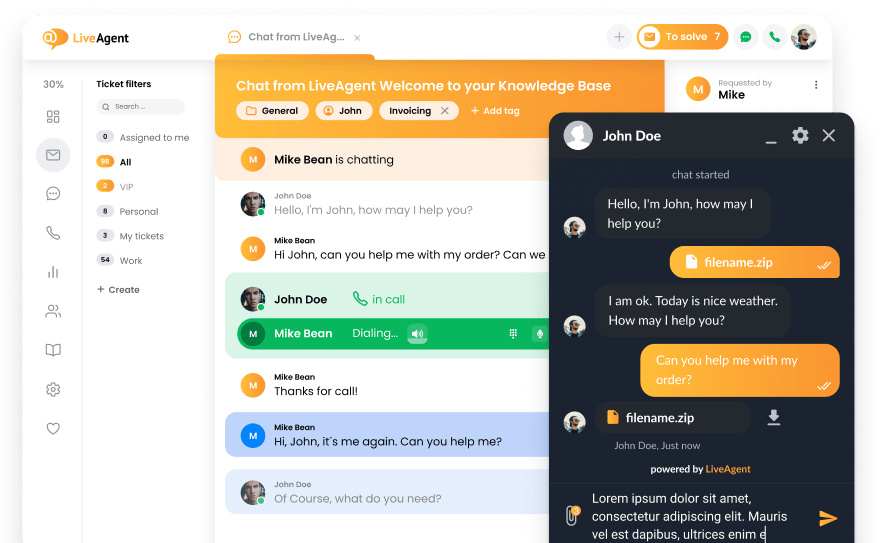Businesses that prioritize the well-being of their customers ultimately thrive in an environment where loyalty is key.
Understanding the nuanced difference between customer happiness and satisfaction helps organizations tailor their approaches for maximum impact. By implementing personalized communication and actively listening to customer feedback, companies can create meaningful emotional connections that foster lasting loyalty.
This article will provide actionable tips and real-life examples on how to elevate customer happiness throughout your organization, emphasizing the role LiveAgent can play in overcoming challenges and enhancing customer relationships.
Understanding the distinction between customer happiness and satisfaction
While customer satisfaction measures how well services meet expectations, customer happiness delves deeper. It reflects an emotional connection that fosters brand loyalty.
Satisfied customers appreciate good service. However, happy customers experience exceptional service, making them more likely to remain loyal. Surveys like CSAT assess customer satisfaction focusing on specific interactions. But, customer happiness captures the entire emotional journey with a brand over time.
| Aspect | Customer satisfaction | Customer happiness |
|---|---|---|
| Measurement | Surveys like CSAT | Overall emotional journey |
| Interaction Focus | Specific service interactions | Entire customer journey |
| Loyalty Impact | Not always indicative of loyalty | Strong predictor of brand loyalty |
| Emotional Connection | Limited | Deep emotional engagement |
While customer satisfaction indicates customer health, it lacks the depth of true customer happiness. This happiness includes emotional responses post-engagement. To achieve customer happiness, businesses must build emotional connections throughout the customer journey. This goes beyond meeting performance benchmarks for individual services. By focusing on creating positive experiences, businesses can foster a base of loyal and happy customers.
20 tips to achieve customer happiness
Keeping customers happy requires more than just great products—it’s about delivering exceptional experiences at every touchpoint. Below are 20 practical tips to boost customer satisfaction, build loyalty, and ensure long-term success.
Prioritize personalized communication with customers
Personalized communication is key to customer happiness. A remarkable 76% of customers feel frustrated when interactions lack personalization. To combat this, businesses must unify customer data for genuine engagement. Empowering agents with a 360-degree view of customer information — including purchase history and preferences — enables effective and personalized communication.
Personalization involves understanding that every customer is unique. By leveraging data, businesses can tailor individual journeys based on buyer habits and behaviors. In fact, high standards for customer service, noted as important by 99% of consumers, include factors like responsiveness and accountability.
Here’s how to prioritize personalized communication:
- Collect and Analyze Data: Gather customer data for meaningful insights.
- Tailor Interactions: Use insights to customize each customer’s experience.
- Close the Feedback Loop: Communicate consistently and make changes based on feedback to build trust.
Incorporating these strategies enhances experiences, boosts satisfaction, and fosters loyalty. By focusing on personalized service, businesses lay the foundation for long-term customer relationships.
Actively listen to customer feedback
Actively listening to customer feedback is vital to keeping customers happy and satisfied. It signals to them that their opinions matter and reduces the chance of dissatisfaction from feeling ignored. A continuous and structured process for collecting feedback is key to gaining valuable insights. This process can lead to significant improvements in customer experiences.
Here are some steps businesses can take:
- Use Surveys and Feedback Forms: Regularly ask for input from your customers.
- Analyze Feedback: Look at both positive and critical comments to find areas that need improvement.
- Act on Insights: Implement necessary changes to products or services based on the insights gathered.
Empathy is also crucial during customer interactions. Showing understanding and care builds trust and strengthens the relationship between the customer and your brand. This not only enhances customer loyalty but also their overall happiness.
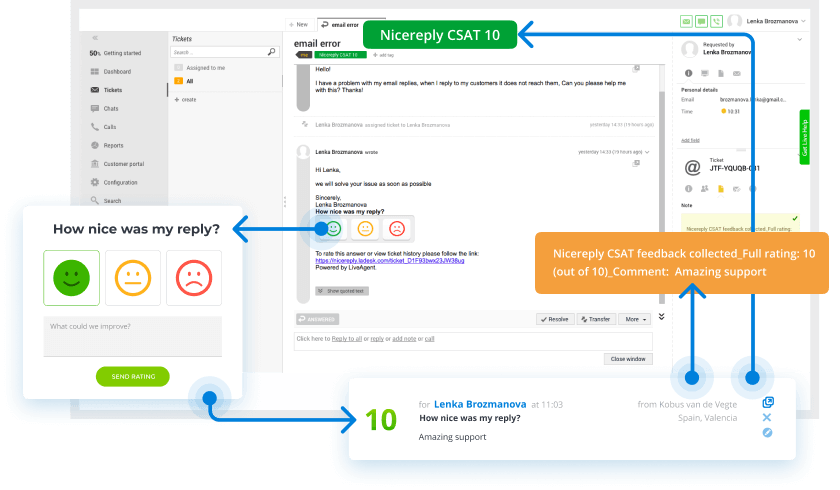
Utilizing customer feedback effectively can greatly boost customer satisfaction and loyalty. Tools like LiveAgent can help manage feedback, streamline processes, and ensure businesses are responsive to their customers. This support is key to fostering long-term customer happiness.
Swiftly address complaints and issues
Swiftly addressing complaints and issues is vital for maintaining customer satisfaction. Research shows that half of customers will switch to a competitor after just one bad experience. This means efficient issue handling is crucial. A playbook for customer interactions helps ensure that employees can resolve problems effectively, enhancing customer satisfaction.
Proactive communication is key. Informing customers about updates or changes builds trust and decreases frustration. This approach makes customers feel heard and understood.
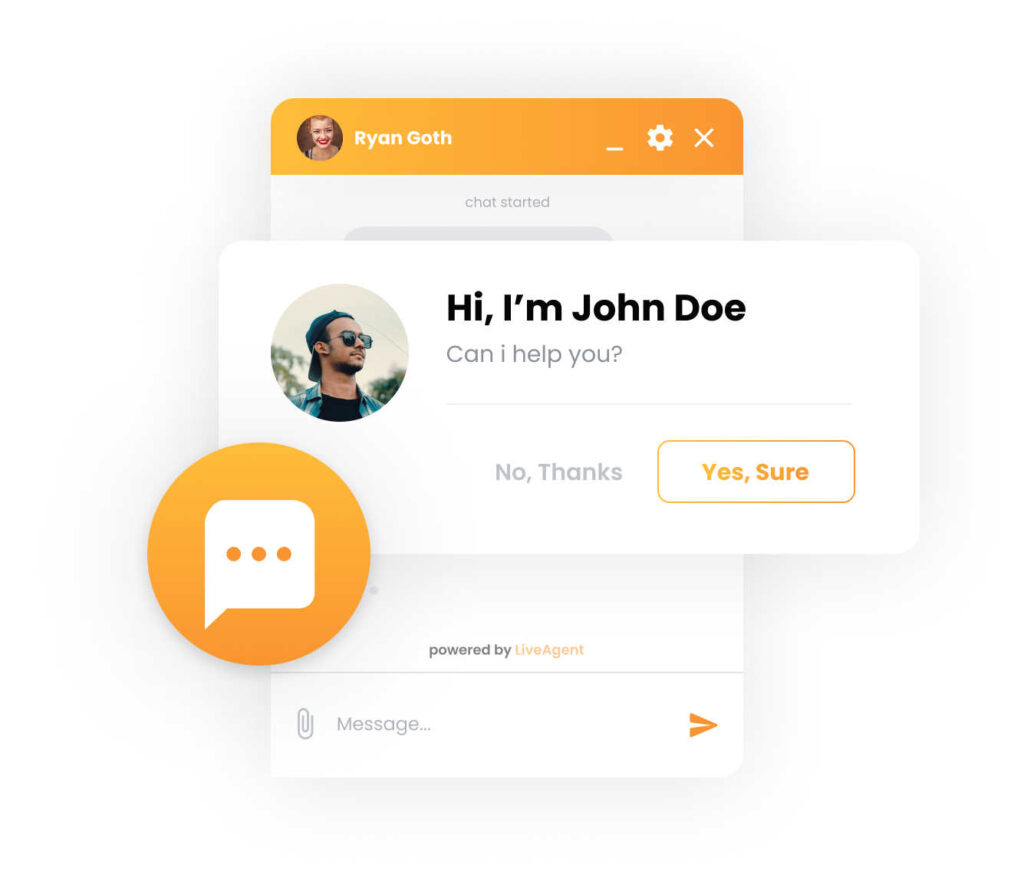
Regularly addressing customer feedback, including complaints, shows that the business values customer concerns and is committed to improvement. Timely and effective problem resolution signals that customer satisfaction is a top priority, which can enhance customer loyalty.
To visualize these strategies, consider the following tips:
- Create a Playbook: Develop a guide for handling common issues.
- Communicate Proactively: Keep customers informed to build trust.
- Respond Promptly to Feedback: Show customers their input matters.
These strategies, combined, form the backbone of a loyal customer base and ensure happy and satisfied customers.
Implement loyalty programs to enhance relationships
These programs transform customer satisfaction into happiness by offering experiences that go beyond mere transactions. They provide incentives like discounts or freebies, creating a sense of belonging for repeat customers. Moreover, the emotional connection fostered within a loyalty program often leads to greater brand loyalty.
Benefits of loyalty programs:
- Incentives: Offer discounts or freebies.
- Emotional Connection: Build deeper ties with the brand.
- Repeat Business: Motivate customers with points or tiered rewards.
A well-designed loyalty program can employ various strategies, such as rewards based on spending levels, referrals, or purchase frequency. For example, a points system can automate rewards, making it easier for customers to understand and engage. This can seamlessly encourage repeat purchases and elevate customer experiences.
| Strategy | Example |
|---|---|
| Spending Levels | Earn points for every dollar spent |
| Referrals | Receive discounts for referrals |
| Purchase Frequency | Bonuses for regular purchases |
To succeed, ensure your loyalty program is simple and rewarding, fostering an ongoing cycle of customer happiness.
Increase customer happiness effortlessly
Delight your customers with exceptional experiences. Happy customers stay loyal, leave positive reviews, and drive more business growth.
Offer rewards and incentives for customer engagement
Offering rewards and incentives can be a powerful tool for boosting customer engagement and happiness. Loyalty programs play a crucial role in achieving this by rewarding repeat purchases and fostering customer retention. Customers are attracted to these programs for the tangible rewards such as discounts or freebies, but the real magic happens when these rewards enhance their overall experience, turning satisfaction into genuine happiness.
Key strategies for customer engagement:
- Loyalty programs: Encourage repeat purchases with discounts or freebies after milestones like one year of loyalty.
- Special offers: Use unique occasions, like birthdays, to provide exclusive deals and create personalized experiences.
- Referral programs: Offer incentives for referrals to motivate customers to share your brand with others.
| Strategy | Benefit |
|---|---|
| Loyalty Programs | Increases retention and repeat sales |
| Special Offers | Enhances personalized customer journey |
| Referral Programs | Expands customer base through advocacy |
Implementing these strategies not only improves customer loyalty but also transforms interactions into positive experiences. Solutions like LiveAgent can aid this journey by managing customer feedback and interactions, ensuring that your service stays responsive and top-notch.
Maintain exceptional service across all channels
To maintain exceptional service across all channels, businesses must focus on speed and personalization. With 73% of consumers valuing quick resolutions, having multiple communication options like live chat, AI chatbots, and social media is essential. This variety helps customer support teams handle inquiries efficiently without sacrificing the personal touch.
Live phone conversations remain a preferred method, emphasizing the need for multiple communication options to cater to diverse preferences. Furthermore, friendly interactions are crucial, as 91% of customers find them essential for satisfaction. In fact, 97% report feeling happy after even small acts of friendliness.
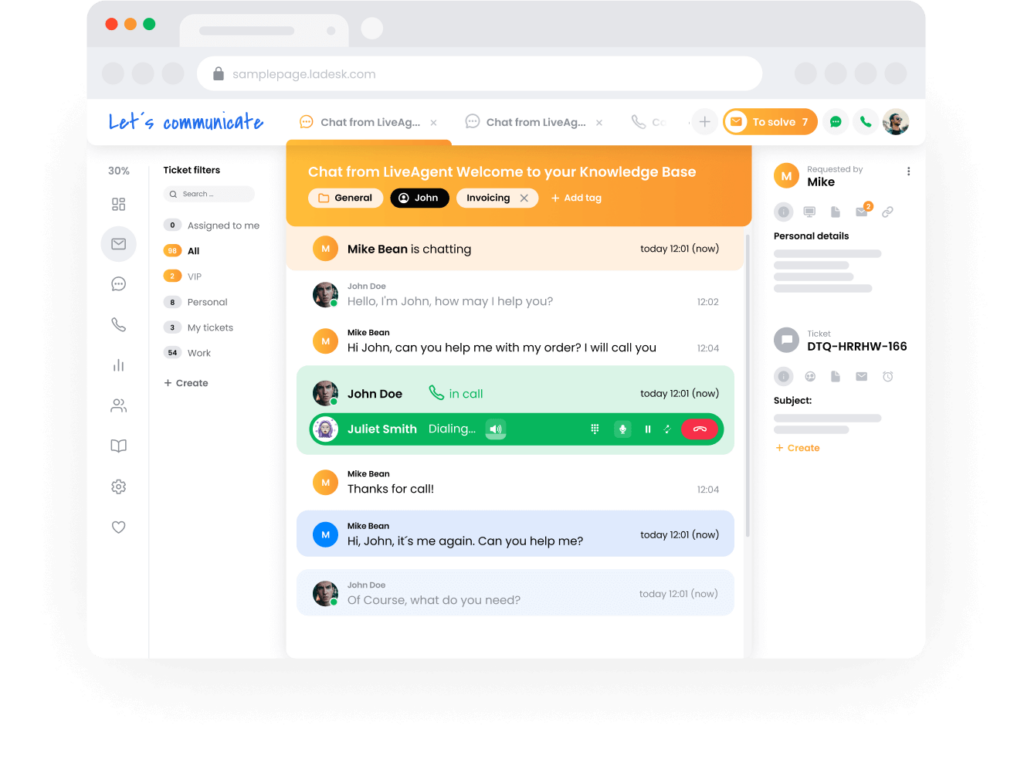
Tracking metrics like net promoter score (NPS) and customer satisfaction score (CSAT) is vital. These metrics help identify areas needing improvement and enhance overall service quality.
Key Strategies:
- Offer diverse support channels: live chat, phone, email, and social media.
- Monitor satisfaction metrics: NPS and CSAT.
- Prioritize speed and personalization.
- Train staff to provide friendly, helpful service.
By following these strategies, businesses can ensure happy customers and foster customer loyalty. LiveAgent can further streamline support processes, improving customer experiences effectively.
Foster a positive employee experience
Fostering a positive employee experience is key to ensuring happy and effective customer interactions. When employees are content, they are more engaged and deliver exceptional service, meeting and exceeding customer expectations. A satisfied workforce exhibits higher empathy, allowing for patient and understanding customer interactions. This deeper connection not only enhances brand loyalty but also strengthens long-term customer relationships.
Investing in employee engagement tools, such as mobile-first apps, can greatly improve employee satisfaction. These tools support seamless communication and collaboration, enhancing overall workplace morale.
Here’s how a positive employee experience benefits businesses:
| Benefit | Impact on Customers |
|---|---|
| Increased Empathy | More patient interactions |
| Enhanced Engagement | Exceptional service delivery |
| Strengthened Connections | Deeper customer relationships |
| Reduced Attrition | Consistent customer experiences |
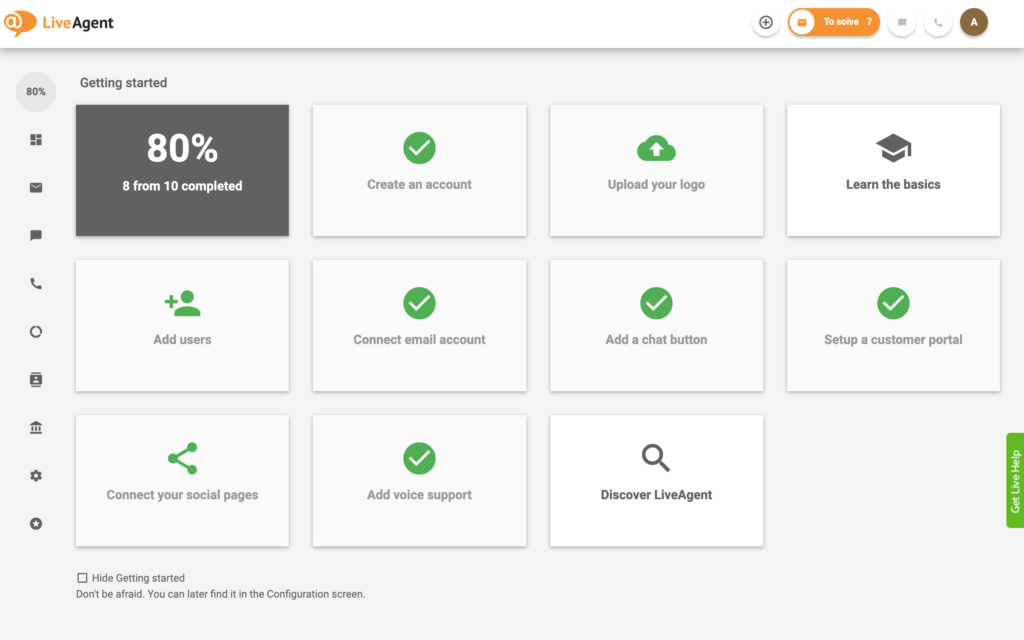
By maintaining a stable and satisfied workforce, businesses minimize attrition, ensuring that customers have consistent and positive interactions over time. Focus on your employees, and the ripple effect will lead to happy and loyal customers.
Create a feedback loop for continuous improvement
Creating a feedback loop is vital for continuous improvement and customer happiness. It consists of five key stages:
- Asking and collecting feedback: Regularly gather customer opinions through surveys or direct interactions.
- Analyzing and planning: Examine feedback to identify patterns and areas for improvement.
- Acknowledging responses: Let customers know their voices are heard. This builds trust and fosters customer loyalty.
- Implementing improvements: Act on the feedback to address customer dissatisfaction and enhance the customer experience.
- Following up: Show customers that their input matters by updating them on the changes made.
By following these steps, businesses can engage with customers and build lasting relationships. This is more cost-effective than acquiring new customers. However, it’s crucial to balance feedback frequency. Long or frequent surveys can lead to disengagement, with 20% of customers choosing not to participate further.
Use customer service metrics to gauge happiness
To ensure customer happiness, businesses must track key customer service metrics. These metrics, such as Net Promoter Score (NPS) and Customer Satisfaction Score (CSAT), provide insights into customer perceptions and highlight areas for improvement.
Tracking satisfaction throughout the customer journey is crucial. By doing so, businesses can pinpoint stages that significantly impact happiness. Analyzing customer behavior during interactions helps identify opportunities to enhance service, making customers feel valued and understood.
Monitoring resolution rates, especially first contact resolution, assesses how well a customer service team meets needs quickly. Efficient problem-solving often leads to higher customer satisfaction, cementing loyal relationships.
Customer feedback is a goldmine for implementing targeted changes. By translating feedback into actionable improvements, businesses can enhance overall experiences.
Here’s how to use these metrics effectively:
- Track NPS and CSAT: Understand customer loyalty and satisfaction.
- Monitor resolution rates: Aim for quick solutions to boost satisfaction.
- Analyze behavior: Learn from interactions to find service gaps.
- Implement feedback: Turn insights into better experiences.
Consider using tools like LiveAgent to streamline these processes, ensuring your team can quickly address and resolve customer issues.
Share success stories of happy customers
Success stories of happy customers underscore the power of positive experiences. For instance, a skincare brand transformed its customer satisfaction by personalizing product offerings. Customers could tailor products to suit their unique skin types, which not only met but exceeded their expectations. This attention to detail led to an 89% repurchase rate.
Another success story involves a tech company that revamped its customer service team. By focusing on personalized interactions and responding promptly to feedback, they achieved a Customer Satisfaction Score (CSAT) above industry standards. This approach cultivated loyal customers and positive reviews.

A clothing retailer introduced a loyalty program that rewarded customers for repeat purchases and referrals. The program included exclusive discounts, fostering a sense of belonging and appreciation. As a result, the company saw a significant boost in customer retention and engagement.
These stories highlight the significance of personalization and loyalty initiatives in customer happiness. Using tools like LiveAgent can further enhance customer interactions by providing efficient support and tracking satisfaction metrics like CSAT and NPS. Such measures ensure customers leave with positive emotions and a strong connection to the brand.
Develop emotional connections with customers
Building emotional connections with customers is key to achieving happiness and loyalty. Relationships thrive on emotional bonds, and your brand’s success depends on this. Here’s how you can nurture these connections:
- Personalized interactions: Use a 360-degree view of customer data to tailor your interactions. Move from treating transactions as mere business deals to forming lasting relationships.
- Loyalty programs: Implement a system that rewards repeat purchases, creating a sense of belonging. This bridges the emotional engagement gap and encourages customer loyalty.
- Understand emotional needs: Offer more than just quality products and good service. Dive deeper into the emotional needs of your customers to differentiate your brand.
Research shows that customers emotionally connected to a brand have more than twice the lifetime value of those who are only satisfied. This emphasizes the importance of emotional engagement in boosting loyalty and retention.
Here’s a quick look at how emotional connections impact customer relationships:
| Approach | Outcome |
|---|---|
| Personalized Interactions | Enhanced emotional engagement |
| Loyalty Programs | Increased repeat purchases |
| Meeting Emotional Needs | Deeper customer connections |
By integrating these strategies, you’ll foster genuine relationships that elevate customer happiness and brand loyalty.
Train employees in customer-centricity
Training in customer service should extend beyond customer-facing roles. Every employee benefits from understanding how to resolve issues. This unified approach can enhance overall customer satisfaction. Employees equipped with proper training are better at delivering exceptional service. This applies across all departments, not just the frontline.
Implementing best practices in customer service is crucial. Many customers face similar problems and effective solutions need consistency. A customer-centric culture is fostered when employees feel valued and engaged. This positive work environment can greatly impact the customer experience.
Investing in training boosts employee engagement. Engaged employees tend to improve product quality and customer interactions. Here’s how:
- Unified Training: Ensure all employees receive consistent customer service education.
- Best Practices: Teach and implement proven methods for common customer issues.
- Employee Engagement: Foster a workplace where employees feel valued.
Training contributes to overall satisfaction and a positive customer experience.
| Key Benefits | Outcome |
|---|---|
| Consistent Customer Service | Higher Customer Satisfaction |
| Employee Engagement | Improved Customer Interactions |
| Customer-Centric Culture | Enhanced Product and Service Quality |
Incorporate these insights for a more rewarding customer journey.
Leverage social media for customer interaction
Social media platforms are powerful tools for businesses to interact with their customers. By providing an informal space, they allow customers to share their thoughts and feelings. This gives businesses insights that might not come through formal feedback channels. Monitoring these discussions helps identify customer sentiments, leading to improvements in customer satisfaction.
Here’s a quick guide to leveraging social media for customer interaction:
- Listen Actively: Monitor conversations to understand customer pain points and sentiments.
- Engage Openly: Respond to comments and feedback to demonstrate you value customer opinions.
- Build Trust: Show your efforts to address concerns, which enhances trust and loyalty.
- Showcase Testimonials: Highlight positive reviews and testimonials to strengthen brand credibility.
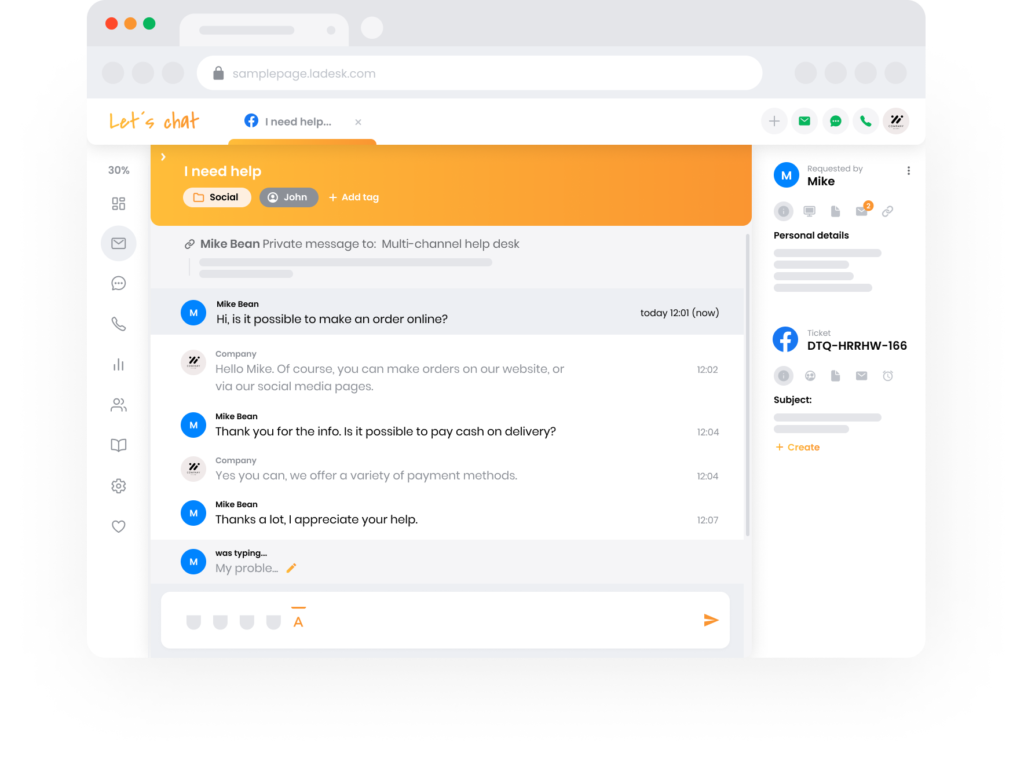
Utilizing social media feedback not only aids in understanding issues but also helps develop strategies to enhance customer happiness. Engaging with customers via social media can positively impact your customer relationship. Businesses can use tools like LiveAgent to streamline these interactions, making the response process more efficient and organized. This approach can contribute to a satisfied customer base and loyal customers.
Highlight customer testimonials in your marketing
Incorporating customer testimonials into your marketing strategy is essential for building trust and credibility. Over 70% of customers say positive reviews boost their trust in a business. Moreover, 88% trust testimonials as much as personal recommendations. These figures show the power of word of mouth, which is ten times more valuable than traditional ads.
Benefits of Customer Testimonials:
- Builds Trust: Positive feedback reassures potential customers.
- Enhances Brand Visibility: Showcasing happy customers boosts your brand.
- Drives Sales: Satisfied customers are more likely to repurchase and recommend.
To maximize the impact, integrate testimonials into email campaigns and social media. Use them in marketing materials to amplify their value.

Remember, happy customers act as promoters for your business. Highlight their positive experiences to attract new buyers and retain loyal ones. By leveraging these testimonials, you can enhance your marketing effectiveness and grow your customer base.
Celebrate customer milestones and achievements
Celebrating customer milestones, such as birthdays and anniversaries, can significantly boost satisfaction and retention. Special offers on these dates make customers feel valued and appreciated, encouraging repeat purchases and loyalty.
Implementing loyalty programs that reward customers after reaching certain milestones is also effective. For instance, offering discounts or freebies can promote retention and reduce churn.
Recognized customers are more likely to spend more and refer others, enhancing overall revenue. Engaging with customers by acknowledging their milestones creates a stronger emotional connection.
Here’s a simple breakdown:
| Strategy | Benefit |
|---|---|
| Birthday Offers | Increases loyalty and repeat purchases |
| Anniversary Deals | Fosters customer appreciation and trust |
| Loyalty Rewards | Reduces churn and boosts retention |
Regularly celebrating customer achievements enriches their experience. This not only enhances the relationship but also increases customer retention and revenue growth. A well-executed strategy can ensure happy customers who are willing to recommend your brand.
Provide a seamless omni-channel experience
To provide a seamless omnichannel experience, it is crucial to meet customers on their preferred platforms, such as email, social media, live chat, or phone. Implementing an effective omnichannel strategy ensures that customer inquiries are routed correctly while keeping the context intact. This prevents the frustration of having to repeat information.
Key tips for a seamless experience:
- Presence: Have your customer service team active on the platforms your customers use most often. This eases communication.
- Technology Integration: Use tools that let service agents access a customer’s interaction history across all channels. This avoids repetitive explanations.
- Consistent Experience: Ensure a unified customer experience by maintaining consistency in tone and quality across platforms.
- Customer Feedback: Regularly gather customer insights to refine and improve your omnichannel approach.
By investing in an omnichannel strategy, businesses not only enhance customer satisfaction but also offer more personalized interactions. LiveAgent can help facilitate this by providing the necessary tools to manage and unify communications, thus building strong customer relationships.
Utilize CRM tools for personalized engagement
Utilizing CRM tools is key to personalized customer engagement. CRM software allows you to track and manage customer interactions. This means you have access to customer history and preferences, which is vital for creating personalized experiences. And this is what most customers crave—71% prefer tailored interactions. This makes effective CRM use crucial.
Integration of CRM platforms provides valuable data that enhances satisfaction and builds deeper relationships. You can use these tools to analyze customer satisfaction metrics like NPS and CSAT. This helps in pinpointing areas for improvement and making strategic decisions to boost customer happiness.
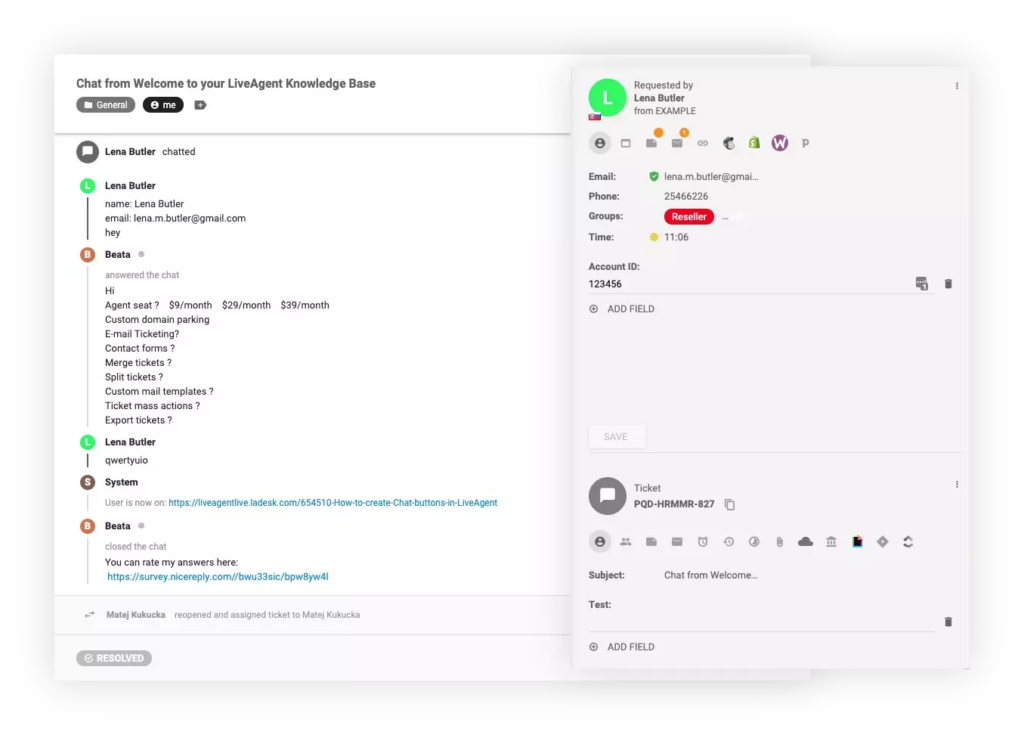
Automation in CRM tools can further improve customer engagement. However, it’s important to maintain human communication options. Balancing automated and personal interactions ensures customer expectations are met.
Here’s a brief list of CRM benefits:
- Personalized interactions based on customer data.
- Improved customer satisfaction with tailored experiences.
- Data-driven insights for strategic decisions.
- Enhanced engagement through automation and human touch.
Tools like LiveAgent help automate these processes while providing diverse communication options, ensuring happy customers and stronger client relationships.
Conduct regular surveys to assess customer sentiment
Conducting regular customer surveys is a strategic approach to understanding customer sentiment. These surveys help measure Customer Satisfaction Scores (CSAT), revealing how well businesses are meeting customer expectations. CSAT scores function as critical Key Performance Indicators (KPIs) that assess the quality of support, products, or services based on direct customer feedback.
Moreover, using the Net Promoter System (NPS) evaluates customer loyalty. NPS gauges how likely customers are to recommend a brand, offering key insights into overall customer happiness.
To improve this process, businesses can implement a structured, ongoing system for collecting customer feedback. This strategy plays a vital role in addressing changing customer preferences and market trends. Utilizing AI-powered survey software further streamlines this process. Such technology provides a more comprehensive view of customer needs and concerns by easily collecting and interpreting customer sentiment.
Here’s a quick list to summarize:
- Conduct regular customer surveys.
- Measure CSAT and NPS for insights.
- Use AI-powered tools to collect and analyze data.
- Keep feedback processes structured and continuous.
This approach ensures that businesses can gather actionable insights and adapt to the evolving marketplace effectively.
Be transparent in your communication
Transparency in communication is crucial for nurturing customer trust and building long-term relationships. When customers feel valued, they are more likely to remain loyal. Admitting mistakes and apologizing when disruptions occur can help organizations recover effectively, reinforcing customer loyalty. Sharing information about the situation and the steps being taken to resolve issues demonstrates a commitment to honesty. This approach not only supports customer satisfaction but also saves time and resources in the long run.
Empowering teams with flexibility is equally important. By allowing them to offer refunds or solutions, organizations can ensure a more responsive and customer-focused approach during challenging times. Consistent and honest communication can transform a negative experience into an opportunity to strengthen customer relationships.
Here’s a simple checklist to maintain transparency:
- Admit Mistakes – Quickly acknowledge when things go wrong.
- Apologize – Offer a genuine apology to customers.
- Provide Solutions – Empower teams to take decisive actions.
- Keep Customers Informed – Share regular updates on ongoing issues.
Practicing transparency helps turn potential negative experiences into positive opportunities for growth and trust-building.
Address common pain points proactively
Addressing common pain points proactively is key to maintaining happy customers and fostering loyalty. Regularly assessing customer happiness through surveys helps identify areas for improvement. This feedback directs efforts to tackle pain points before they become major issues.
Proactive communication plays a crucial role. Keep customers informed about updates or potential issues to build trust and reduce frustrations. This makes clients feel valued and understood. Timely and effective problem resolution also boosts customer satisfaction and shows that their concerns matter.
Creating memorable experiences through small gestures like personalized recommendations or thank-you notes can exceed customer expectations. These actions help in creating a lasting impact and enhancing customer loyalty.
Finally, anticipate customer needs. Engaging proactively not only meets expectations but also prevents small issues from becoming larger problems. By addressing these areas head-on, businesses can create positive experiences and maintain a loyal customer base.
Proactive Steps to Address Pain Points:
| Action | Benefit |
|---|---|
| Conduct satisfaction surveys | Identify improvement areas |
| Implement proactive communication | Builds trust and reduces frustrations |
| Resolve issues quickly | Shows prioritization |
| Offer personalized gestures | Exceeds expectations and fosters loyalty |
Tools like LiveAgent can streamline communication and feedback management, ensuring prompt responses and improved customer interactions.
Examples of successful customer happiness initiatives
Creating happy customers is key to business success. Companies like Southwest Airlines, Patagonia, and Nordstrom excel by offering rewards and incentives that customers eagerly anticipate. This approach maintains momentum in customer happiness over time.
Nike enhances emotional connections through personalized experiences. Their “Nike by You” option lets customers design products that mirror their individuality. This personal touch strengthens bond with the brand.
Providing multiple support channels is vital. With 73% of consumers valuing speedy service, companies use live chat and AI chatbots for quick solutions. This flexibility meets customer demands efficiently.
Loyalty programs also play a crucial role. Offering discounts and freebies for reaching milestones boosts satisfaction and fosters long-term happiness. These programs can transform customer satisfaction into emotional loyalty.
Consistent communication is another success factor. Keeping customers informed about product updates and promotions fosters a sense of connection and belonging, positively affecting their happiness.
| Initiative | Company | Impact |
|---|---|---|
| Rewards & Incentives | Southwest, etc. | Sustained customer happiness |
| Personalized Experience | Nike | Enhanced emotional connections |
| Multiple Support Channels | Various | Quick resolution of service interactions |
| Loyalty Programs | Many | Long-term happiness and loyalty |
These strategies are essential for ensuring happy customers and long-lasting success.
Increase customer happiness effortlessly
Delight your customers with exceptional experiences. Happy customers stay loyal, leave positive reviews, and drive more business growth.
Conclusion
In conclusion, achieving customer happiness is crucial for any business aiming for success. Happy customers are not only loyal but they also become advocates, enhancing your brand through positive reviews and word-of-mouth marketing. This strong reputation can set your company apart from competitors and draw in potential customers.
Satisfied customers tend to spend more, increasing their lifetime value and boosting your business’s revenue. This leads to happier employees, creating a cycle that improves service quality. By prioritizing customer satisfaction, your company can ensure customer retention and secure a thriving customer base.
LiveAgent can be a powerful tool in managing and improving customer interactions. Its features can transform customer service and lead to a loyal, satisfied customer base. Try our 30-day free trial to experience how LiveAgent can elevate your customer service and maintain customer happiness.
Share this article
Understanding customer retention: Definition, importance, and strategies
Master customer retention with 13 proven strategies, key metrics, and real examples. Boost loyalty, profits, and brand reputation today!
Customer appreciation guide: how to say thank you in 19 ways
Discover 19 creative customer appreciation ideas to boost loyalty and satisfaction. Strengthen relationships with heartfelt gestures and gratitude!

 Български
Български  Čeština
Čeština  Dansk
Dansk  Deutsch
Deutsch  Eesti
Eesti  Español
Español  Français
Français  Ελληνικα
Ελληνικα  Hrvatski
Hrvatski  Italiano
Italiano  Latviešu
Latviešu  Lietuviškai
Lietuviškai  Magyar
Magyar  Nederlands
Nederlands  Norsk bokmål
Norsk bokmål  Polski
Polski  Română
Română  Русский
Русский  Slovenčina
Slovenčina  Slovenščina
Slovenščina  简体中文
简体中文  Tagalog
Tagalog  Tiếng Việt
Tiếng Việt  العربية
العربية  Português
Português 



